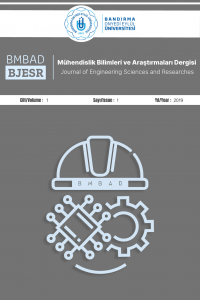Üre-Formaldehit Reçine Mol Oranının Yüksek Yoğunlukta Lif Levhanın (HDF) Mekanik Özellikleri Üzerine Etkileri
HDF, , Mekanik Özellikler, , Üre Formaldehit, Mol Oranı
Effects of Urea–Formaldehyde Resin Mole Ratio on the Mechanical Properties of High-Density Fiberboards (HDF)
HDF, Mechanical Properties, Urea Formaldehyde, Moles Ratio,
___
- [1] A. S. Angelatos, ‘‘NMR structural elucidation of amino resins’’, Journal of Applied Polymer Science, 91(6):3504–3512. DOI:10.1002/app.13538, 2004.
- [2] T. Alpar, T. Faczan, I. Racz and Katoli, G, ‘‘MDF/HDF Production from Plantation Wood Species. Drvna Industrıja, 61 (3) 183-191, 2010.
- [3] N. A. Costa, J. Pereira, J. Ferra, P. Cruz, J. Martins, F. D. Magalhāes, A. Mendes and L. H. Carvalho, ‘‘Scavengers for achieving zero for-maldehyde emission of wood-based panels’’, Wood Science and Technology, 47, 1261–1272, 2013.
- [4] H. Eroğlu ve M. Usta, ‘‘Lif Levha Üretim Teknolojisi, Karadeniz Teknik Üniversitesi, Orman Fakültesi, Genel Yayın No: 200, Fakülte Yayın No: 30, Trabzon, s. 351, 2000.
- [5] Faostat, ‘‘Forestry Production and Trade. Food and Agriculture Organization of the United Nations’’, http://www.fao.org/faostat/en/#data/FO, Accessed: 24.01.2020.
- [6] W. J. Grigsby, J. E.P. Carpenter and R. Sargent, ‘‘Investigating the Extent of Urea Formaldehyde Resin Cure in Medium Density Fiberboard: Resin Extractability and Fiber Effects’’, Journal of Wood Chemistry and Technology Vol; 34, Issue 3, https://doi.org/10.1080/02773813.2013.861850, 2014.
- [7] W. J. Grigsby, and A. Thumm, ‘‘Resin and wax distribution and mobility during medium density fibreboard manufacture’’, European J. Wood and Wood Products, 70(1–3): 337–348. DOI: 10.1007/s00107-011-0560-0, 2012.
- [8] W.J. Grigsby, A. G. McDonald, A. Thumm and C. Loxton, ‘‘X-ray photoelectron spectroscopy determination of urea formaldehyde resin coverage on MDF fibre’’, Holz als Roh- und Werkstoff: European Journal of Wood and Wood Industries. 62(5):358-364, 2004.
- [9] R. Hashim, O. Sulaiman, R.N. Kumar, P. F. Tamyez, R.J. Murphy and Z. Ali, ‘‘Physical and mechanical properties of flame-retardant urea formaldehyde medium density fiberboard’’, Journal of Materials Processing Technology.vol;209, issue;2, pages 635-640. https://doi.org/10.1016/j.jmatprotec.2008.02.036, 2009.
- [10] S. Kim, ‘‘The reduction of indoor air pollutant from wood-based composite by adding pozzolan for building materials’’, Constr Build Mater 23(6):2319–2323, 2009.
- [11] P. Louis Cyr, B. Riedl and X. M. Wang, ‘‘Investigation of Urea-Melamine-Formaldehyde (UMF) resin penetration in Medium-Density Fiberboard (MDF) by High Resolution Confocal Laser Scanning Microscopy’’, Holz als Roh- und Werkstoff: European Journal of Wood and Wood Products. 66(2):129-134, 2008.
- [12] J. Martins, C. Coelho, J. Ferra, P. Cruz and L. Carvalho, ‘‘Low formaldehyde emission MDF overlaid with wood veneer: bonding problems assessment’’, International Wood Products Journal. Vol;3 pages 1 -31, 2012.
- [13] A. Mao and M.G. Kim, ‘‘Low mole ratio urea–melamine–formaldehyde resins entailing ıncreased methylene-ether group contents and their formaldehyde emission potentials of wood composite boards’’, BioResources, 8 (3): 4659-4675, 2013.
- [14] B. D. Park and H. W. Jeong, ‘‘Hydrolytic stability and crystallinity of cured ureaformaldehyde resin adhesives with different formaldehyde/urea mole ratios. International Journal of Adhesion and Adhesives, 31(6): 524–529. DOI: 10.1016/j.ijadhadh.2011.05.001, 2011.
- [15] B. D. Park, S. M. Lee and J. K. Roh, ‘‘Effects of formaldehyde/urea mole ratio and melamine content on the hydrolytic stability of cured urea-melamine-formaldehyde resin’’, European Journal of Wood and Wood Products, 67(1): 121–123. DOI: 10.1007/s00107-008-0277-x, 2009.
- [16] E. Roffael, B. Dix, C. Behn and G. Bär, ‘‘Use of UF-bonded recycling particle- and fibreboards in MDF-production’’, European Journal of Wood and Wood Products vol; 68, pages121–128, 2010.
- [17] E. Roffael and C. Behn, ‘‘On the influence of binder content in particleboards bonded with resins of high and low molar ratio on the formaldehyde release measured by the perforator method’’, European Journal of Wood and Wood Products vol; 70, pages819–822, 2012.
- [18] F. R. Sani and A. A. Enayiti, ‘‘Reduced use of urea-formaldehyde resin and press time due to the use of melamine resin-impregnated paper waste in MDF’’, Journal of the Indian Academy of Wood Science. vol. 17, pages100–105, 2020.
- [19] TS 642-ISO 554, ‘‘Kondisyonlama ve/veya Deney İçin Standart Atmosfer – Özellikler’’, TSE, Ankara, 1997.
- [20] TS-EN 316, ‘‘Odundan mamul lif levhalar-tarifler, sınıflandırma ve semboller’’, TSE, Ankara, 2011.
- [21] TS EN 310 ‘‘Ahşap esaslı-paneller, eğilme ve eğilme dayanımı esneklik modüllerinin belirlenmesi’’, TSE, Ankara, 1999.
- [22] TS EN 319 ‘‘Yonga levhalar ve suntalar, levha düzlemine dik çekme dayanımının belirlenmesi’’, TSE, Ankara, 1999.
- [23] TS-EN 323, ‘‘Ahşap esaslı levhalar-birim hacim ağırlığının tayini’’, TSE, Ankara, 1999.
- [24] TS EN 324-1, ‘‘Ahşap esaslı levhalar-levha boyutlarının tayini-bölüm 1: kalınlık, genişlik ve uzunluğun tayini’’, TSE, Ankara, 1999.
- [25] TS EN 325, ‘‘Ahşap esaslı levhalar-deney numunelerinin boyutlarının tayini. TSE, Ankara, 2008.
- [26] TS EN 326-1, ‘‘Ahşap esaslı levhalar-numune alma kesme ve muayene bölüm 1: deney numunelerinin seçimi, kesimi ve deney sonuçlarının gösterilmesi’’, TSE, Ankara, 1999.
- [27] TS 64-1 EN 622-1, ‘‘Lif levhalar özellikler-bölüm 1: genel özellikler’’, TSE, Ankara, 2005.
- [28] C. Xing, B. Riedl, A. Cloutier and G. He, ‘‘The effect of urea-formaldehyde resin pre-cure on the internal bond of medium density fiberboard’’, Holz als Roh- und Werkstoff vol:62, pages 439–444, 2004.
- [29] Z. Quea, T. Furunoa, S. Katoha and Y. Nishinob, ‘‘Effects of urea–formaldehyde resin mole ratio on the properties of particleboard’’, Building and Environment 42, pages1257–1263, 2007.
- ISSN: 2687-4415
- Yayın Aralığı: Yılda 2 Sayı
- Başlangıç: 2019
- Yayıncı: Bandırma Onyedi Eylül Üniversitesi
Sonlu Elemanlar Yöntemi ile Dağıtım Transformatörlerinin Harmonik Yük Kayıplarının Analizi
Kalsit Mineral Katkılı Orta Yoğunlukta Liflevha (MDF)’nin Yanma Performansının Araştırılması
Keban Magmatik Kayaçları’nın Petrografik Ve Jeokimyasal Özellikleri (Keban-Elazığ)
Mustafa Eren RİZELİ, Abdullah SAR, Mehmet Ali ERTÜRK
Çelik Levhalı Perde-Çerçeve Binaların Dinamik Analizi İçin Bir Yaklaşım
Yasin GÜNGÖR, Kanat Burak BOZDOĞAN
Farklı Yöntemlerle Sentezlenmiş olan ZnO’in Organik Güneş Hücrelerinde Verim Üzerine Etkisi
Semih YURTDAŞ, Mustafa KARAMAN, Cem TOZLU
Fatih KARİPOĞLU, Samet ÖZTÜRK, Mustafa Serdar GENÇ
Ekmeklik Buğday Islah Programlarında Gluten Kalitesinin Değerlendirilmesi
Yaşar KARADUMAN, Arzu AKIN, Emel YILMAZ, Seda DOĞAN, Savaş BELEN
Covid-19 Sürecinin Türkiye’nin Elektrik Enerjisi Üzerindeki Etkilerinin İncelenmesi
